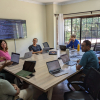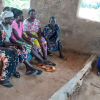Dialogue at a glance: supporting the contribution of dialogue to peace through modern media
By analysing the role of dialogue, we can help in strengthening this communications contribution for future peace, democracy and prosperity efforts. Miguel Varela of mediatEUr recently argued this point at the interactive brainstorm‘Innovative thinking on strategic approaches to conflict management’ that was organized by the Knowledge Platform Security & Rule of Law in The Hague on 7 October.

Today, Ukraine represents an image of crisis as one of Europe’s most urgent conflicts. It is hard to see how this country may get back to its previous path of peace and prosperity. mediatEUr started its formal work in Ukraine in 2013 and due to the urgency of the conflict, all attention was focused on crisis management. As a mediation and dialogue support organization, mediatEUr was particularly interested in how the role of dialogue could help strengthen the social fabric in Ukraine and thereby eventually contribute to the resolution of the conflict. As a process that allows opponents to transcend differences, having a dialogue is an opportunity for rivals to interact in a safe space and eventually work together towards a resolution.
In early 2014, mediatEUr developed a fact-finding process to determine if discussions were being had in Ukraine, together with the International Centre for Policy Studies and Interpeace. As a result, there were two key findings from the process.
- There is a great wealth of dialogue initiatives and capacity in nearly all regions of Ukraine. From high-level national efforts supported by the international organizations to smaller-scale initiatives run by individuals and small organizations in their communities, dialogue is practiced in Ukraine as a constructive response to conflict. The scope of these initiatives is ample: they deal with conflict between local authorities and civil society; they bring ‘Maidan’ and ‘anti-Maidan’ actors together; they assess the possibilities for reform and; they promote exchange between patriotic and ‘pro-Russian’ groups.
- There is an opportunity to strengthen the connections between these initiatives, as well as their capacity to communicate their findings to reform and policy-making actors.
Disconnections
These findings resulted in a map of diverse community dialogue initiatives that do have potential and capacity, however they need to be interconnected and linked with initiatives in policy-making. While having a dialogue is a result in itself, the participants may be discouraged if they feel their concerns are not addressed by decision-makers. On the one hand, the team observed multiple community dialogues thatproduced a wealth of ideas and opportunities, plus a promoted understanding of the Ukrainian society. Yet on the other hand, policy-makers in Ukraine sought to build a reform agenda that would make the country more stable. Regrettably, we did not see a bridge between the two approaches. Policy-makers were unaware of the value (and at times the existence) of dialogue in Ukraine, yet all the while dialogue practitioners found it difficult to not only inform the stability agenda or even connect with other dialogue initiatives, but also to support the overall reform process. As policy-making could benefit from the ideas generated by dialogue groups, the disconnection between the two rendered their results nearly invisible.
A second characteristic of disconnection also became apparent after discussing the results of the fact-finding process with international organizations. Not all of them were aware of the existence of dialogue processes in Ukraine. Indeed, several foreign organizations had been supporting a number of dialogue initiatives but the support remained largely vague. They stood ready to support dialogue for peace in Ukraine but they struggled to identify the initiatives working towards it.

The Dialogue Support Platform
mediatEUr saw the opportunity to develop a system that could connect all these actors while showcasing the contribution of dialogue and promoting reflective learning. Without building yet another dialogue initiative, the organization saw the potential in strengthening what already existed. The key was the combination of modern media and in-country work to generate an interactive image of dialogue in Ukraine, also known as a ‘dialogue map’. In combination, mediatEUr developed the Dialogue Support Platform (DSP) in partnership with the UNDP with the aims to: build a space for reflection and learning between dialogue actors; promote good dialogue practices and showcase its impact and; strengthen collaboration between communities and other dialogue actors and policy-makers. (Watch a DSP introduction video here.)
With Ukraine now in active dialogues, connecting initiatives to each another will help in the promotion of reflective learning, capturing needs and discussing ways to promote their results. In addition, the information from the ground is now being linked into an online platform where it can be mapped, analyzed and expanded. Participants in the Dialogue Support Platform also have access to a set of tools that can help them showcase their work results on an interactive map.
As a final note, the Dialogue Support Platform does not seek to replace the work being done by local and foreign dialogue organizations in Ukraine. On the contrary, it seeks to provide them with a space to share and reflect on their work and methods without establishing a new dialogue approach.
mediatEUr and the UNDP have only scratched the surface with this process and a number of challenges are ringing clear, including: identification of initiatives; reaching the most conflict-affected areas and; including actors that are not prone to dialogue. With the support of the international community, the team hopes to optimize the contribution of the Dialogue Support Platform and ultimately support dialogue towards a peaceful, prosperous and democratic Ukraine.
|
Join the conversation This blog post is part of an online continuation of the conversation started at the Interactive Brainstorm ‘Innovative thinking on strategic approaches to conflict management’, held on 7 October 2015 in the Hague. The Platform and The Broker are organizing a series of online blog posts on this topic, in order to inform the Platform’s broader network about the discussions that have taken place during the event, and to invite you to join the conversation. This series of blog posts revolves around innovative ideas on how to improve current conflict response mechanisms, ranging from prevention to reaction to rebuilding. |
Photo credit: Minsk forum on Ukraine / AFP PHOTO / PRESIDENTIAL PRESS SERVICE / POOL / MYKOLA LAZARENKO / European External Action Service via Flickr






Login or register for free to get all access to our network publications. Members can also connect and discuss with other members. Participate in our network.